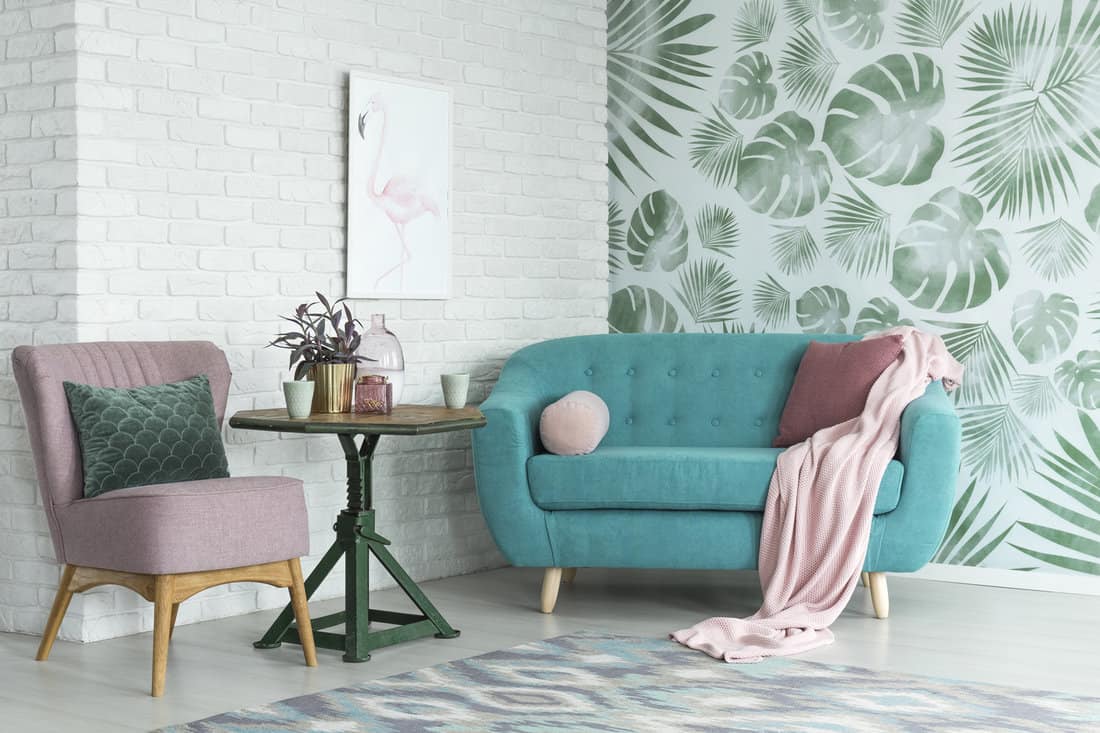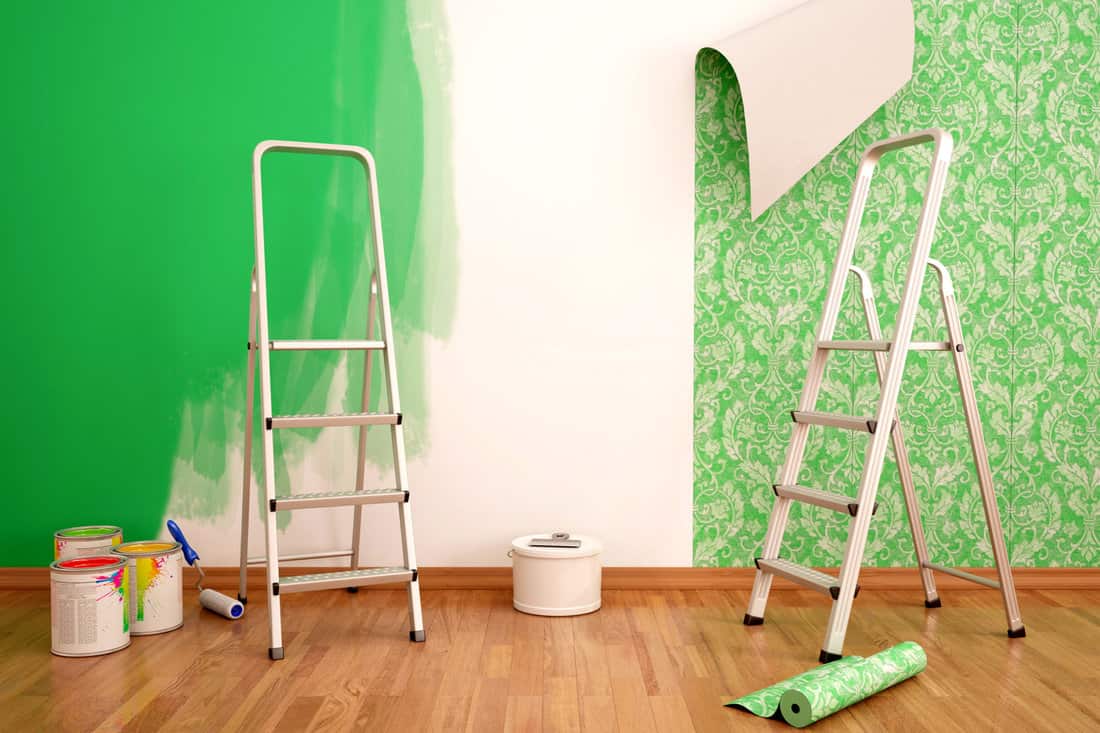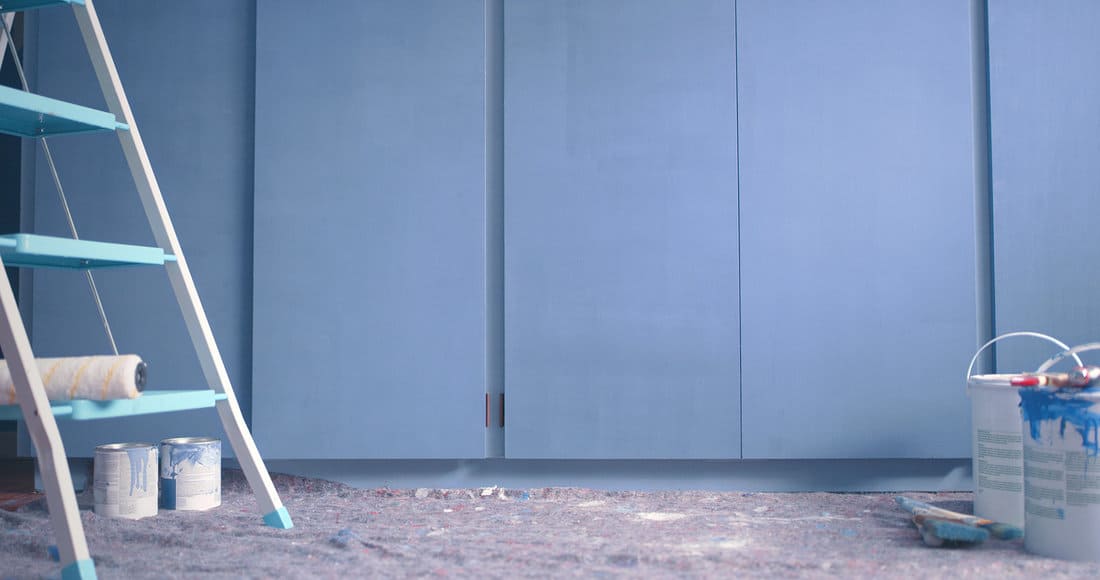Are you bored with your current wallpaper, or think it is outdated? Are you wondering whether it is possible to paint over the wallpaper? And, if possible, what type of paint should you use, and are there any exceptions or considerations? We researched to provide you with a detailed guide for this process.
Yes, you can paint over wallpaper if it is well-attached to the wall and is still in good condition. To successfully paint over your wallpaper, here are the things you should do:
- Clean the wallpaper
- Inspect the wallpaper for damages and repair
- Prime the wallpaper
- Paint the walls
To learn how to paint over wallpaper, keep reading for a guide on how to go about it. Also, find out if there is any special paint you should use, and if there are those that you can't use. In addition, learn the benefits of painting over wallpaper, and the cost estimate for doing so.
![Glueing Wallpapers at Home. - Can You Paint Over Wallpaper With Any Type Of Paint? [A Detailed Guide]](https://homedecorbliss.com/wp-content/uploads/2022/09/Glueing-Wallpapers-at-Home.-Can-You-Paint-Over-Wallpaper-With-Any-Type-Of-Paint-A-Detailed-Guide-2.png)
How To Paint Over Your Wallpaper

We may include affiliate links and curated AI content to highlight top design styles.
Painting over wallpaper is possible if it is still well-adhered to the wall with no parts coming off or bubbles underneath. When it comes to painting, you can use either water-based or oil-based paint.
However, the secret is in the primer you use. Don’t use a water-based primer, as it can loosen the wallpaper. Instead, use one that is oil-based.
So, if you have decided that you are going to paint over the existing wallpaper, follow the guide below for a high-quality finish:
Clean The Wallpaper
Take a damp cloth and wipe the dust and dirt off the walls so that the primer can more easily bond. Imagine a greasy and grimy kitchen wallpaper; primer will definitely not stick to it. Don’t soak the cloth in too much water, or the adhesive holding the wallpaper may come off.
You can find this Trisodium Phosphate on Amazon.
Alternatively, you can use Trisodium Phosphate, which cleans through all kinds of stains, including mold and soot. And the best part is that it does not have ammonia, fragrance, or bleach.
However, you should note that this product may have been banned in some states due to environmental concerns. So, if you can’t find it in your area, some alternatives include borax or dawn dishwashing soap.
After cleaning, allow the wallpaper to dry.
Inspect And Repair Any Damages To The Wallpaper
With time, wallpaper fades and peels. It can crack and develop holes or have corners that are coming off. All these make it look messy and unappealing, which is why you should identify all the damages and carry out the necessary repairs.
Use adhesive to re-attach the corners that are rolling or tearing off. Alternatively, you can lift the wallpaper at these corners using a putty knife and cut out the spoilt parts.
You can find this wall repair kit on Amazon.
Afterward, fill these spaces with a wall repair kit like the one shown above to even out the surface, and then sand it lightly after drying. In fact, if the whole surface is uneven, it may be a good idea to sand the entire wallpaper to smoothen it out. A fine-grit sandpaper will be most suitable.
This is an assortment of grit sandpaper that you can find on Amazon.
Next, secure the edges to the wall by using caulk to ensure it cannot detach easily. That way you prevent moisture from finding its way under the wallpaper.
For the cracks and holes, apply a joint compound to fill them up.
Prime The Wallpaper
Check out this painter's tape on Amazon.
Before priming the walls, use painter's tape like the one above to cover the areas that need protection while painting. Use it to cover the trim, molding, baseboard, or wainscotting. As mentioned earlier, remember to use an oil-based primer before applying the paint of your choice.
Have a look at this paint roller brush kit on Amazon.
Paint The Wallpaper
![Glueing Wallpapers at Home. - Can You Paint Over Wallpaper With Any Type Of Paint? [A Detailed Guide]](https://homedecorbliss.com/wp-content/uploads/2022/09/Glueing-Wallpapers-at-Home..jpg)
Rollers are the best for painting a wide surface area, while brushes are best for the edges and corners. Apply the first coat and wait for it to dry.
The instructions in the manual will indicate how long the paint will take to dry. However, the weather plays a big part in the length of time paint should dry.
A second coat is recommended, especially if you are painting over dark wallpaper or if it has a striking pattern. Allow drying as per instructions while observing the weather to gauge when it will dry.
After checking several times if it is dry, peel off the painter's tape only if the wall feels dry when you touch it. And, finally, you have a new look.
Is It Worth Painting Over Wallpaper?

Why should you paint over wallpaper when you can remove it and paint the surface afresh? Indeed, you will achieve a much better finish. However, you can still achieve the new look you desire by painting your current wallpaper.
As much as this is possible, there are a few considerations to observe.
First, it does not make much sense to paint over wallpaper that is extensively damaged, because you will not achieve the results you desire. Second, you may likely end up with a messy and unattractive wall, requiring you to repeat the job.
Therefore, you can only paint over your wallpaper if it is in good condition. The following are some of the benefits of choosing to paint over wallpaper:
Easier To Revamp Your Wall
You might find it tedious to remove the wallpaper. Stripping off the wallpaper and scraping off the parts stuck to the drywall is difficult and quite involving. Thus, it may be easier to change the look of your room or entire home by simply painting over the wallpaper.
Prevents Damages
Damages can occur as you remove the wallpaper. It may come off with parts of the drywall creating unsightly cracks. This problem only gets worse if you have to remove many layers of wallpaper.
Less Expensive
You save a lot on expenses since all you have to do is clean the wall, repair any minor damages, and apply your paint.
Faster
It's more time-consuming and intensive to pull down your wallpaper. As seen above, you have to strip off the paper, then scrape the areas where it is stuck.
Afterward, you’ll have to remove any adhesive that is still on the wall and then wash it clean. However, you don’t have to go through this process when painting the wallpaper.
If you aim to take the shortest time possible, painting the wallpaper is your best bet.
Cost Of Painting Over Wallpaper

A painter will charge you between $1 and $3 to paint one square foot of surface area. If you'll be charged per hour, be ready to pay $20 to $50. You might pay extra for prepping the wallpaper.
So, on average you are likely to pay between $180 and $650 to paint a whole room. To paint a living room costs between $600 and $2,000. The cost of painting a kitchen ranges from $150 to $250, while a bedroom costs between $350 and $850.
If you prefer painting a room yourself, your expenses will range between $100 and $300, paint and supplies inclusive. However, it can be quite involving. You’ll be required to remove the furniture to prevent paint from splashing on it.
Cleaning and preparing the surface is part of the job. Hiring a professional to paint the same room will cost you between $300 and $800.
Depending on the type of paint you prefer, the cost per gallon of oil paint is between $20 and $80. Latex or acrylic latex is a little cheaper, costing between $20 and $50. A primer costs $20 per gallon but can be cheaper by $5 or $10 if you buy larger quantities.
In Closing
It is possible to paint wallpaper when you want to change the appearance of a room or a home. This means you don't necessarily have to remove the wallpaper.
However, it is important to note that you can only do this if your wallpaper properly adheres to your wall and it is in good condition.
There are steps to follow for successfully painting your wallpaper. Prepping is the first step if you want to achieve your goal. Most importantly, don't forget to use an oil-based primer instead of one that is water-based.
To learn more about wallpapers, read our previous posts below:
Can You Paint Over Wallpaper With Any Type Of Paint A Detailed Guide
Can You Use Command Strips On Wallpaper








